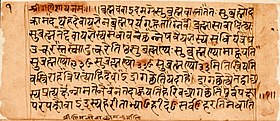
Back براهمانا Arabic ব্রাহ্মণ (হিন্দুশাস্ত্র) Bengali/Bangla Brahmana Catalan Bráhmany Czech Brahmanas German Brahmana Esperanto Bráhmana (texto) Spanish Braahmanad Estonian Brahmana Basque براهمنهها Persian
| Part of a series on |
| Hindu scriptures and texts |
|---|
 |
| Related Hindu texts |

The Brahmanas (/ˈbrɑːmənəz/; Sanskrit: ब्राह्मणम्, IAST: Brāhmaṇam) are Vedic śruti works attached to the Samhitas (hymns and mantras) of the Rig, Sama, Yajur, and Atharva Vedas. They are a secondary layer or classification of Sanskrit texts embedded within each Veda, which explain and instruct on the performance of Vedic rituals (in which the related Samhitas are recited). In addition to explaining the symbolism and meaning of the Samhitas, Brahmana literature also expounds scientific knowledge of the Vedic Period, including observational astronomy and, particularly in relation to altar construction, geometry. Divergent in nature, some Brahmanas also contain mystical and philosophical material that constitutes Aranyakas and Upanishads.[1]
Each Veda has one or more of its own Brahmanas, and each Brahmana is generally associated with a particular Shakha or Vedic school. Less than twenty Brahmanas are currently extant, as most have been lost or destroyed. Dating of the final codification of the Brahmanas and associated Vedic texts is controversial, as they were likely recorded after several centuries of oral transmission.[2] The oldest Brahmana is dated to about 900 BCE, while the most recent are dated to around 700 BCE.[3][4]
- ^ Cite error: The named reference
:5was invoked but never defined (see the help page). - ^ Klaus Klostermaier (2007), A Survey of Hinduism, Third Edition, State University of New York Press, ISBN 978-0791470824, page 47
- ^ Michael Witzel, "Tracing the Vedic dialects" in Dialectes dans les litteratures Indo-Aryennes ed. Caillat, Paris, 1989, 97–265.
- ^ Biswas et al (1989), Cosmic Perspectives, Cambridge University Press, ISBN 978-0521343541, pages 42–43